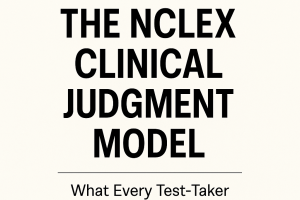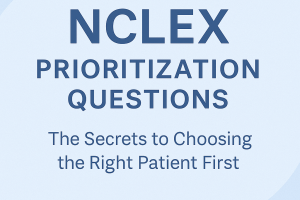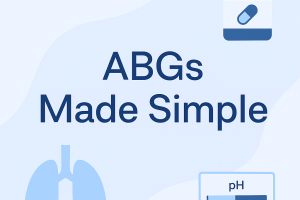Congenital Disorders: Understanding Congenital Heart Defects for NCLEX Preparation

Congenital disorders, especially congenital heart defects (CHDs), are among the most common birth anomalies that nurses must be equipped to understand and manage. These structural problems in the heart’s anatomy can lead to serious complications, requiring surgical intervention, long-term management, or even lifelong care. As a nurse, it’s essential to understand the types of congenital heart defects, their presentation, diagnostic methods, and nursing care to be well-prepared for NCLEX questions on this topic.
This blog post will provide an overview of common congenital heart defects, focusing on their pathophysiology, nursing interventions, and tips for NCLEX preparation.
What Are Congenital Heart Defects (CHDs)?
Congenital heart defects are structural problems of the heart that are present at birth. These defects occur when the heart or blood vessels near the heart don’t develop properly during fetal development. They range from simple conditions that require little or no treatment to complex defects that require multiple surgeries over time.
CHDs can be categorized as cyanotic (causing oxygen-poor blood to circulate to the body, leading to cyanosis) or acyanotic (where oxygen-rich blood still circulates, but the heart works harder due to structural issues).
Types of Congenital Heart Defects
1. Atrial Septal Defect (ASD)
- Pathophysiology: ASD is a hole in the septum that divides the two upper chambers (atria) of the heart, allowing oxygen-rich blood from the left atrium to mix with oxygen-poor blood in the right atrium.
- Symptoms: Often asymptomatic in early childhood, but can lead to fatigue, shortness of breath, and heart palpitations in adulthood if untreated.
- Nursing Care: Monitor for signs of heart failure in severe cases. Surgical repair may be required if the defect is large or causes significant symptoms.
2. Ventricular Septal Defect (VSD)
- Pathophysiology: VSD is a hole in the septum separating the ventricles, allowing blood to flow from the left ventricle (higher pressure) to the right ventricle (lower pressure).
- Symptoms: Small VSDs may be asymptomatic. Larger defects can lead to heart failure, poor growth, respiratory infections, and a characteristic loud heart murmur.
- Nursing Care: Monitor for signs of heart failure, difficulty feeding, and respiratory distress. Surgical repair may be necessary if the defect doesn’t close on its own.
3. Patent Ductus Arteriosus (PDA)
- Pathophysiology: PDA occurs when the ductus arteriosus, a fetal blood vessel that connects the pulmonary artery to the aorta, fails to close after birth. This results in the mixing of oxygenated and deoxygenated blood.
- Symptoms: May present with a “machinery-like” heart murmur, poor weight gain, respiratory issues, and increased risk of bacterial endocarditis.
- Nursing Care: Administer indomethacin (a medication that encourages PDA closure in some cases), monitor for signs of respiratory distress, and prepare for possible surgical intervention.
4. Tetralogy of Fallot (TOF)
- Pathophysiology: TOF is a combination of four defects: VSD, pulmonary stenosis, overriding aorta, and right ventricular hypertrophy. This results in oxygen-poor blood being circulated to the body.
- Symptoms: Cyanosis (especially during crying or feeding), failure to thrive, and “tet spells” (episodes of severe cyanosis).
- Nursing Care: During tet spells, place the child in a knee-chest position, administer oxygen, and possibly morphine. Surgery is required to correct the defect.
5. Coarctation of the Aorta
- Pathophysiology: Coarctation of the aorta is the narrowing of the aorta, which obstructs blood flow from the heart to the rest of the body.
- Symptoms: Hypertension in the upper extremities, weak or absent pulses in the lower extremities, leg cramps, and heart failure.
- Nursing Care: Monitor for blood pressure discrepancies between the arms and legs, respiratory distress, and signs of heart failure. Surgery or balloon angioplasty may be required.
6. Transposition of the Great Arteries (TGA)
- Pathophysiology: In TGA, the two main arteries (pulmonary artery and aorta) are reversed, causing oxygen-poor blood to circulate to the body and oxygen-rich blood to recirculate in the lungs.
- Symptoms: Severe cyanosis after birth, poor feeding, and rapid breathing.
- Nursing Care: Administer prostaglandin E1 to keep the ductus arteriosus open (to allow mixing of oxygenated and deoxygenated blood). Surgical correction is necessary.
Nursing Care for Congenital Heart Defects
Nursing interventions for children with congenital heart defects focus on early detection, management of symptoms, and preparation for surgical interventions. Here’s what you need to know:
- Monitoring Vital Signs:
Keep close track of heart rate, respiratory rate, oxygen saturation, and blood pressure. Early signs of heart failure, such as tachycardia, tachypnea, and poor perfusion, should be addressed promptly. - Feeding Support:
Many children with CHDs have difficulty feeding due to fatigue and dyspnea. Small, frequent feedings and high-calorie formula can help. In severe cases, tube feeding may be necessary. - Managing Cyanosis and Tet Spells:
For cyanotic defects like Tetralogy of Fallot, ensure proper positioning (knee-chest position during tet spells), administer oxygen, and be prepared to give medications like morphine or beta-blockers. - Infection Prevention:
Children with CHDs are at higher risk for endocarditis and respiratory infections. Provide education on good hygiene, administer prophylactic antibiotics before certain procedures, and encourage timely vaccinations. - Educating Parents:
It’s crucial to involve parents in the care of their child by educating them about the nature of the defect, signs of worsening symptoms (e.g., difficulty breathing, poor feeding, or cyanosis), and when to seek medical attention. - Preoperative and Postoperative Care:
For children undergoing surgery, nurses play a vital role in preoperative teaching, ensuring the child is stable before surgery, and providing postoperative care, including pain management, monitoring for infection, and promoting early mobilization.
Sample NCLEX Questions
Question 1
A nurse is caring for an infant with Tetralogy of Fallot. The child suddenly becomes cyanotic and has difficulty breathing. What is the nurse’s priority action?
A. Administer oxygen via face mask
B. Place the child in a knee-chest position
C. Start an IV line for fluids
D. Notify the healthcare provider immediately
Answer: B. Place the child in a knee-chest position. This increases systemic vascular resistance and reduces the right-to-left shunt.
Question 2
A child with a ventricular septal defect (VSD) is admitted for a surgical consult. Which symptom should the nurse expect to find during the assessment?
A. Cyanosis during feeding
B. Bounding pulses in the upper extremities
C. Loud, harsh murmur at the left sternal border
D. Weak femoral pulses
Answer: C. Loud, harsh murmur at the left sternal border. This is a classic sign of VSD due to turbulent blood flow.
Question 3
A child with coarctation of the aorta presents with hypertension in the upper extremities. What other assessment finding is expected?
A. Bounding pulses in the feet
B. Decreased blood pressure in the lower extremities
C. Warm, flushed lower extremities
D. Cyanosis of the lips
Answer: B. Decreased blood pressure in the lower extremities. Coarctation obstructs blood flow, leading to higher pressure in the upper body and lower pressure in the lower extremities.
NCLEX Tips for Congenital Heart Defects
- Understand the physiology: Be familiar with how each heart defect affects blood flow and oxygenation, as this will guide your understanding of symptoms and treatment.
- Learn the nursing interventions: Know how to manage common complications like cyanosis, respiratory distress, and feeding difficulties.
- Focus on parent education: The NCLEX may test your ability to explain conditions and care to parents in a clear, compassionate way.
- Surgical care: Be prepared for questions about preoperative and postoperative care for children undergoing heart surgery.
Conclusion
Congenital heart defects require specialized nursing care and a deep understanding of pediatric cardiology. By studying the different types of CHDs, their symptoms, and appropriate nursing interventions, you’ll be better prepared for NCLEX questions on this topic and more confident in providing care to children with these conditions.






